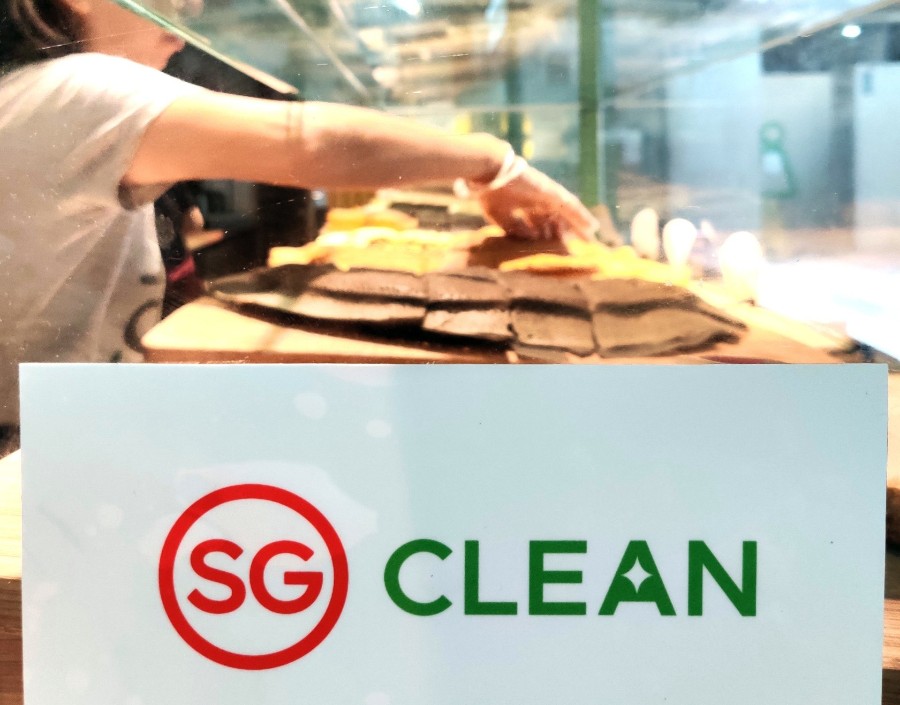ADVISORY ON COVID-19 FOR BUSINESSES
atrede
The Ministry of Health (MOH) has announced various safe distancing measures1 to be taken to reduce the risk of local spread of COVID-19. Such measures are to limit large numbers of people gathering in close proximity over a prolonged period of time.
The following advisories outline safe distancing measures for the food & beverage and retail establishments to provide a safer dining and shopping experience.
Food & Beverage Establishments
These guidelines would apply to F&B establishments from smaller establishments such as takeaway kiosks and cafes, to larger ones such as restaurants.
Queue management
- Reduce the number of people gathering outside the outlet by putting in place queue management solutions. These include taking down diner details and calling them when there are seats available.
- Where queues are unavoidable, clearly mark queueing areas and space customers out in the queue, at a safe distance of at least one metre apart.
- Incorporate mobile ordering and payment solutions2 so that diners can order and make payments directly without having to wait at the cashier.
- Pre-ordering solutions are recommended for F&B kiosks to minimise physical clustering of customers waiting to pick up their orders.
Table and seating management
- While related diners (e.g. family members, couples) can be seated together without staggered seating, ensure a distance of at least one metre between tables or different groups of diners.
Communication
- Train service staff to provide clear communication on safe distancing measures with customers.
- Put up simple signage to clearly communicate these practices to customers.
Other measures to ensure the well-being of customers
These safe distancing measures complement the sanitation and hygiene practices recommended under the SG Clean campaign. These include temperature and health screening of employees; implementation of cleanliness and hygiene practices; as well as compliance with MOH health advisories.
In addition, F&B establishments with customers who are seated for their meals should:
- Facilitate contact tracing by taking down of the contact details of at least one member in each dining group. Govtech has made available a cloud-based visitor registration system. F&B establishments are encouraged to use the system or their own equivalent apps or processes.
- Implement temperature screening and health health declaration measures for diners, as well as turn away those who are unwell.
- Improve ventilation (e.g. open windows for natural ventilation).
- Provide hand sanitisers to frontline staff who handle cash and other devices and who are unable to wash their hands frequently with soap and water.
- Conduct frequent disinfection of common spaces, and increase frequency of cleaning for high touch surfaces and interactive components within the establishment (e.g. turnstiles and smart kiosks)
- Clean tables thoroughly with disinfecting agents after each diner vacates the table. Hand sanitisers should be placed in close proximity to high touch surfaces like door handles so that staff and diners can sanitise their hands after touching these surfaces.
In implementing the abovementioned measures, employers should establish open communication channels with their staff and customers. Employers, staff and customers should be regularly reminded to exercise social responsibility by observing good personal hygiene and monitoring their health conditions. Those who are unwell, even with mild flu-like symptoms, should see a doctor and stay at home to prevent spreading illness to others.
The Government also encourages trade associations and chambers to explain these precautionary measures to their respective members. We seek your understanding on the safe distancing arrangements and your cooperation in adopting these measures.
Safe distancing measures for hawker centres
Hawker centres are food establishments, with well-ventilated environment and a common dining area where the seating is not managed by stall holders. NEA and Town Councils are progressively marking out seats at our hawker centres to guide patrons on how to practice safe distancing. Patrons are encouraged to sit on the unmarked seats when dining in groups or sharing table with other diners at our hawker centres. Patrons are also encouraged to practise safe distancing when queueing up at food stalls.
With this arrangement, seating capacity for ‘dining-in’ could become more limited. To support our hawkers and hawker culture, NEA encourages patrons to continue making cooked food purchases by considering food deliveries or take-outs. In addition, patrons should not leave food scraps or soiled tissue paper on the tables, and should return all used crockery and trays to keep the table clean for the next patron. This will help minimise the risk of disease transmission, maintain the cleanliness of our hawker centres, and safeguard public health.
Frequently asked questions (FAQs)
- Is it mandatory for F&B establishments to exercise safe distancing?
F&B establishments are required to comply with safe distancing measures. These precautionary measures can help reduce the risk of local spread of COVID-19. Businesses which do not implement or comply with the government’s safe distancing advisories may be ineligible for government grants and loan assistance. - Smaller F&B establishments may find it challenging to implement safe distancing measures. Any recommendations for them?
The Government understands that seating configurations may differ from establishment to establishment due to the size of the dining space or the presence of fixed tables and seats. Smaller establishments can either reduce the number of tables or implement staggered seating by blocking out or removing some seats. The general principle is to maintain a practical physical distance of at least a metre, while allowing dining to carry on as normally as possible.Coffee shops and food courts can consider putting up signage to educate and encourage consumers to observe safe distancing, where possible. - My outlet is a kiosk that offers take-outs only. How do I carry out contact tracing and temperature screening of my customers?
For kiosk outlets where there is shorter contact duration, we understand that contact tracing and temperature screening may not be feasible. However, staff at these outlets should be trained to communicate good practices to customers (e.g. avoid forming clusters while waiting for the food). You could also put up signage to communicate these messages.GovTech is launching a new TraceTogether app, which will help to log data of close contacts, stored locally on mobile phones. You could encourage your customers to download the app. - Some hawker centres have marked out seats and some not. Why is that, and when can we expect all hawker centres to have alternate seats marked out?
We are progressively marking out seats in all our hawker centres to guide the practice of safe distancing in a community dining environment. As the marking is usually done outside the hawker centres’ operating hours, it cannot be done overnight.

Retail Establishments
These guidelines would apply to all retail establishments, including retail outlets, supermarkets, department stores and shopping malls.
Crowd and queue management
- Space out the queueing of shoppers (at least one metre apart) for fitting rooms and cashiers.
- Use floor markers to mark queueing positions for shoppers.
- Encourage the use of self-checkouts, and cashless or contactless payment to speed up processing of payment and reduce cash-handling.
- Limit the number of shoppers within the store to allow for at least a metre spacing between them. This can be done by letting shoppers into the store progressively3.
Communication
- Train service staff to provide clear communication on safe distancing measures.
- Put up simple signage to clearly communicate these practices to shoppers.
Other measures to ensure the well-being of shoppers
These safe distancing measures complement the sanitation and hygiene practices recommended under the SG Clean campaign. These include temperature and health screening of employees; implementation of cleanliness and hygiene practices; as well as compliance with MOH health advisories.
In addition, retail establishments should:
- Place hand sanitisers in close proximity to high touch surfaces like door handles so that staff and shoppers can sanitise their hands after touching these surfaces.
- Conduct frequent disinfection of common spaces and increase frequency of cleaning of high touch surfaces and interactive components such as self-checkout kiosks.
- Remove product testers and samples that require customer contact, e.g. cosmetics and food samples.
In implementing the abovementioned measures, employers should establish open communication channels with their staff and shoppers. Employers, staff and shoppers are reminded to exercise social responsibility by observing good personal hygiene, monitoring their health conditions. Those who are unwell, even with mild flu-like symptoms, should see a doctor and stay at home to prevent spreading illness to others.
The Government also encourages trade associations and chambers to explain these precautionary measures to their respective members. We seek your understanding on the safe distancing arrangements and your cooperation in adopting these measures.
Frequently asked questions (FAQs)
- Is it mandatory for retail establishments to exercise safe distancing?
Retail establishments are required to comply with safe distancing measures. These precautionary measures can help reduce the risk of local spread of COVID-19. Businesses which do not implement or comply with the government’s safe distancing advisories may be ineligible for government grants and loan assistance. - Smaller retail establishments may find it challenging to practise safe distancing. Any recommendations for them?
The Government understands that smaller retail establishments might experience space constraints when implementing safe distancing measures. The general principle is for retail establishments to regulate the number of shoppers within the store so that a metre spacing between them could be maintained while retail operations continue normally.





